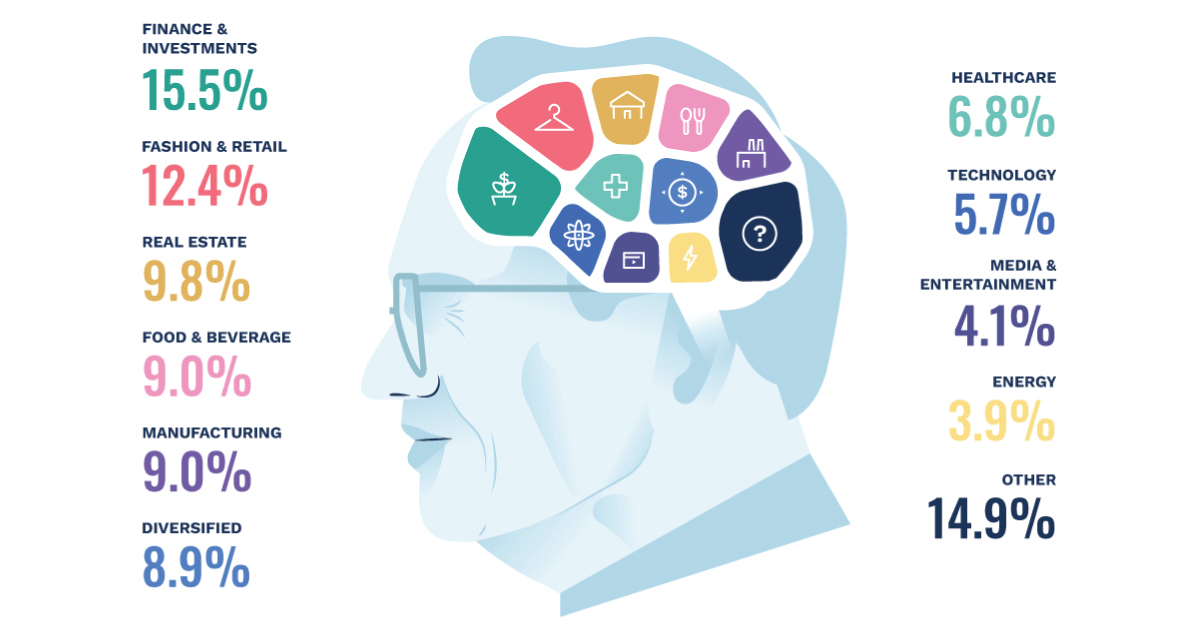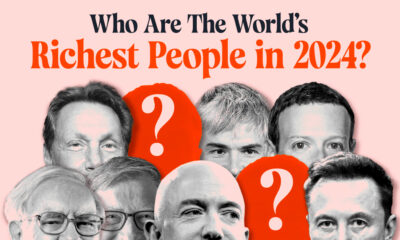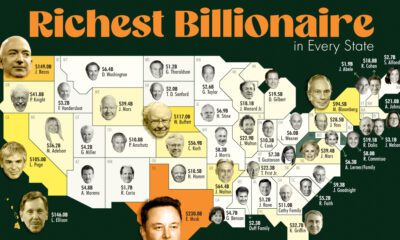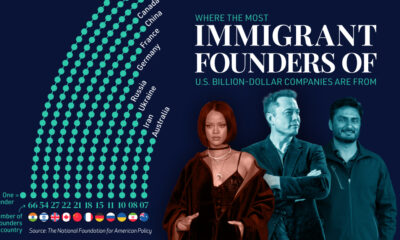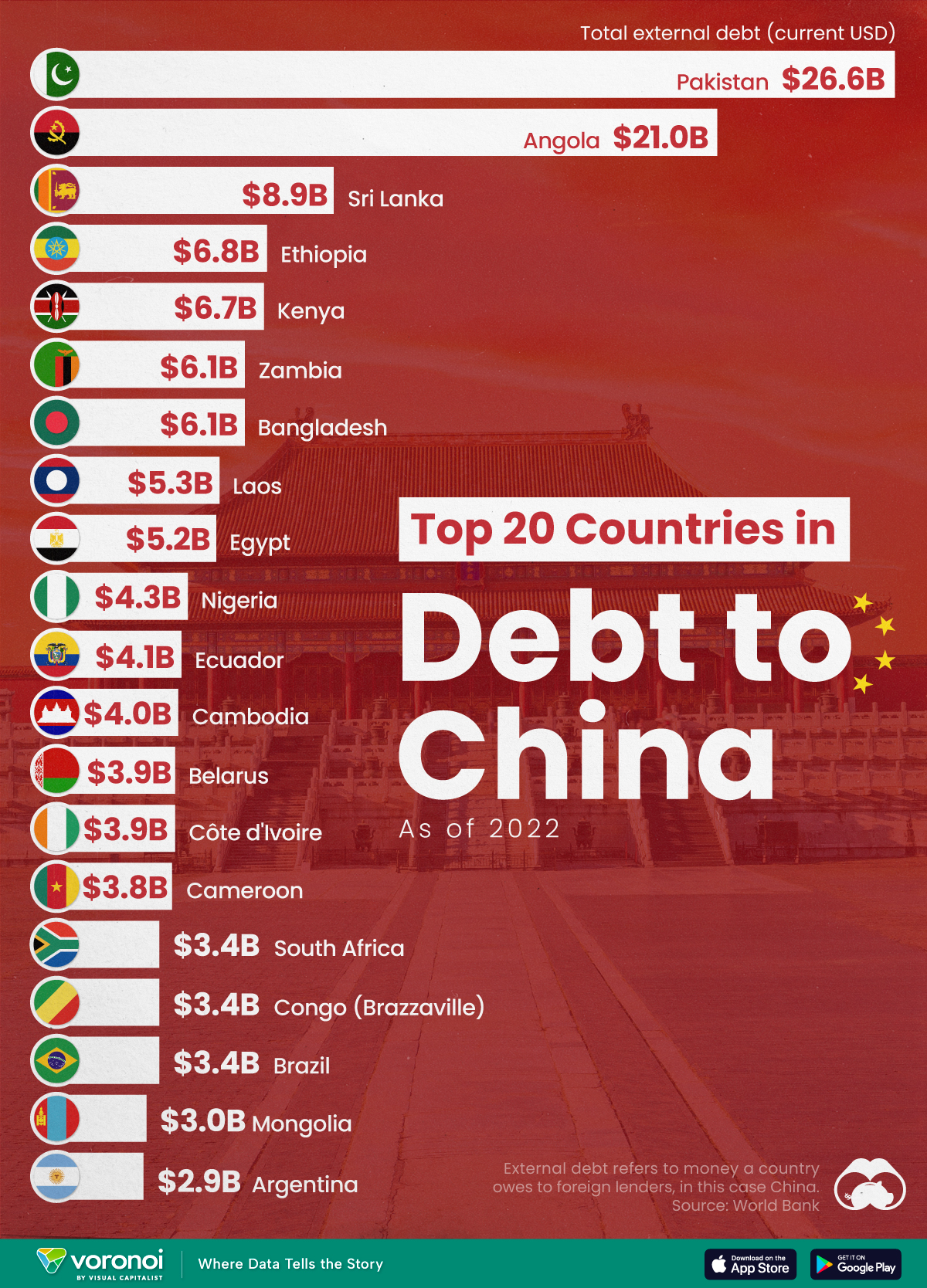Money
The World’s Billionaires, by Generation

The World’s Billionaires, by Generation
What similarities do the world’s billionaires share? What are their differences?
At the age of 12, Elon Musk built his first video game. Similarly, Mark Zuckerberg shared an interest in computer programming, building a simple messaging platform at the same age. The co-founder of Oracle, Larry Ellison, developed programming skills at college. All three span different generations and made their fortunes in tech.
In this infographic from BusinessFinancing.co.uk, we explore some characteristics of billionaires across generations, including their average net worth, top sectors, number of children, and most common city of residence.
The World’s Billionaires, by Generation
Using data from Forbes here is how each generation of the world’s billionaires break down.
Silent Generation
- Born: 1928-1945
- Average Net Worth: $5.5 billion
- Most Popular Residence: New York, U.S.
Silent Generation billionaires are the wealthiest on average across generations. With CEO of Berkshire Hathaway Warren Buffett and Zara founder Amancio Ortega among its ranks, Silent Generation billionaires are most likely to be in finance, fashion, and real estate industries.
| Top 5 | Sector | % |
|---|---|---|
| 1 | Finance & Investments | 15.5% |
| 2 | Fashion & Retail | 12.4% |
| 3 | Real Estate | 9.8% |
| 4 | Food & Beverage | 9.0% |
| 5 | Manufacturing | 9.0% |
Media mogul Rupert Murdoch, who owns The Wall Street Journal, Fox News, and The New York Post, is also part of this group. He has a net worth of $13 billion.
Baby Boomer
- Born: 1946-1964
- Average Net Worth: $4.6 billion
- Most Popular Residence: New York, U.S.
Like the Silent Generation, billionaire Boomers are most likely to be in finance. Stephen Schwarzman, founder of private equity firm Blackstone Group, R. Budi Hartono, the richest person in Indonesia, and Ray Dalio, head of Bridgewater Associates, all fall into this generation.
Boomer billionaires are much less likely to be in the tech industry, though Jeff Bezos and Bill Gates have amassed their fortunes in this area.
| Top 5 | Sector | % |
|---|---|---|
| 1 | Finance & Investments | 14.2% |
| 2 | Manufacturing | 12.9% |
| 3 | Fashion & Retail | 10.6% |
| 4 | Technology | 8.7% |
| 5 | Healthcare | 8.5% |
With a net worth of $150 billion, LVMH chair Bernard Arnault is the second richest person in the world. Francoise Bettencourt-Meyers, vice-chairwoman of L’Oreal, ranks 12th. Both fashion conglomerates are based in France and helmed by billionaire Boomers.
Generation X
- Born: 1965-1980
- Average Net Worth: $4.4 billion
- Most popular Residence: Beijing, China
The world’s billionaires in Gen X are not only predominantly in tech, but are most likely to live in Beijing, China. Ma Huateng, founder of social media conglomerate Tencent Holdings, created instant messaging platform QQ in his early 20s. Colin Huang built one of China’s largest e-commerce platforms, Pinduoduo, in 2015.
| Top 5 | Sector | % |
|---|---|---|
| 1 | Technology | 24.2% |
| 2 | Manufacturing | 13.4% |
| 3 | Finance & Investments | 11.6% |
| 4 | Healthcare | 8.0% |
| 5 | Fashion & Retail | 7.6% |
Gen X billionaires also include Elon Musk and Google co-founder Larry Page.
Millennials
- Born: 1981-1996
- Average Net Worth: $5.1 billion
- Most Popular Residence: San Francisco, U.S.
With the second-highest average net worth after the Silent Generation, millennial billionaires are seen predominantly in tech and finance. Roughly 100 billionaires worldwide fall into this category overall.
Mark Zuckerberg is the only millennial billionaire among the top 10 richest globally.
| Top 5 | Sector | % |
|---|---|---|
| 1 | Technology | 31.0% |
| 2 | Finance & Investments | 12.9% |
| 3 | Fashion & Retail | 8.6% |
| 4 | Media & Entertainment | 8.6% |
| 5 | Automotive | 6.9% |
Brian Chesky (co-founder of Airbnb), Bobby Murphy and Evan Spiegel (co-founders of Snapchat), and Swiss billionaire Guillaume Pousaz are all part of this billionaire cohort.
Generational Trends
What other trends are seen across the world’s billionaires?
| Silent Generation Billionaires | Baby Boomer Billionaires | Generation X Billionaires | Millennial Billionaires | |
|---|---|---|---|---|
| Women | 9.6% | 9.8% | 11.9% | 19.1% |
| Self-Made | 65.7% | 71.0% | 80.7% | 66.4% |
| U.S. Citizens | 38.2% | 27.3% | 17.7% | 30.2% |
| EU Citizens | 17.5% | 11.7% | 13.0% | 18.1% |
| Living Outside the U.S. | 61.9% | 73.2% | 81.8% | 65.5% |
| Married | 78.9% | 86.5% | 83.6% | 68.4% |
Millennial billionaires are the most likely to be women, with roughly double the rate of all other generations at 19%. Notable billionaire women include Anna Kasprzak, who co-owns Danish shoe company ECCO and Brazil’s Anne-Marie Werninghaus.
Self-made billionaires are most likely to be Gen X. Over 80% of billionaires are in this category, including Google co-founder Sergey Brin and Mu Rongjun, co-founder of Meituan, a company similar to Yelp. At the same time, the most billionaires living outside of the U.S. (81%) were born in this generation.
Billionaire Boomers are most likely to be married. The Silent Generation, meanwhile, are most likely to be U.S. citizens, with hedge fund manager George Soros and the world’s oldest billionaire, George Joseph (100) who founded insurance firm Mercury General, in this set.
Notable exceptions include Robert Kuok (98), the richest person in Malaysia, and Masatoshi Ito (97), chair of Japan’s largest retailer.
Economy
Ranked: The Top 20 Countries in Debt to China
The 20 nations featured in this graphic each owe billions in debt to China, posing concerns for their economic future.
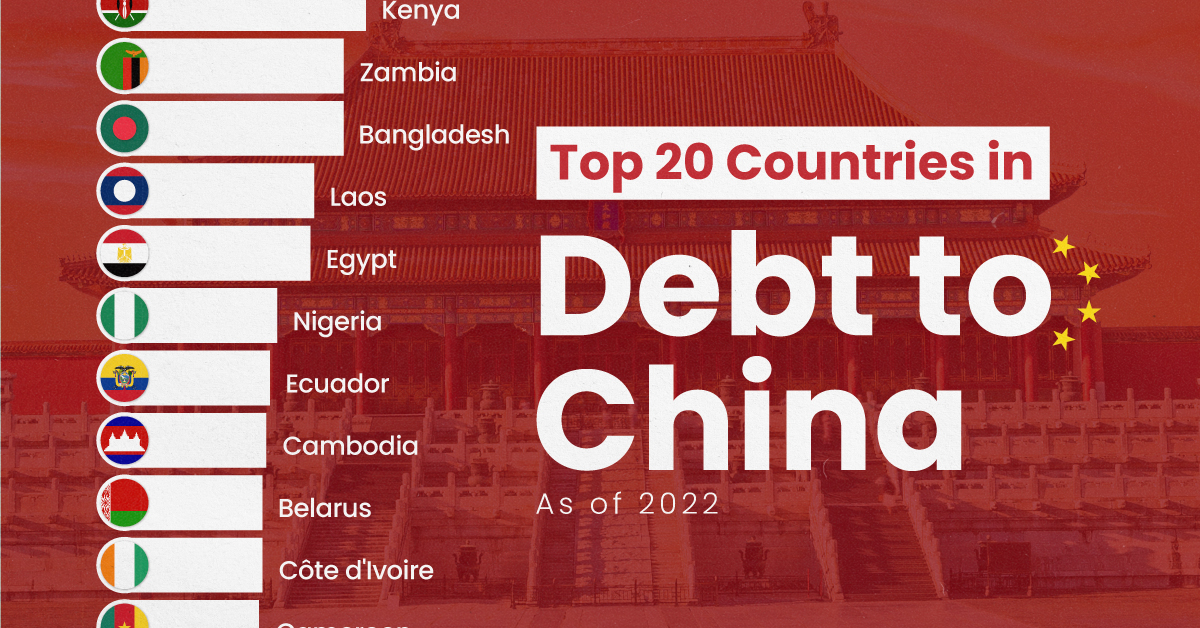
Ranked: The Top 20 Countries in Debt to China
This was originally posted on our Voronoi app. Download the app for free on iOS or Android and discover incredible data-driven charts from a variety of trusted sources.
In this graphic, we ranked the top 20 countries by their amount of debt to China. These figures are as of 2022, and come from the World Bank (accessed via Yahoo Finance).
The data used to make this graphic can be found in the table below.
| Country | Total external debt to China ($B) |
|---|---|
| 🇵🇰 Pakistan | $26.6 |
| 🇦🇴 Angola | $21.0 |
| 🇱🇰 Sri Lanka | $8.9 |
| 🇪🇹 Ethiopia | $6.8 |
| 🇰🇪 Kenya | $6.7 |
| 🇧🇩 Bangladesh | $6.1 |
| 🇿🇲 Zambia | $6.1 |
| 🇱🇦 Laos | $5.3 |
| 🇪🇬 Egypt | $5.2 |
| 🇳🇬 Nigeria | $4.3 |
| 🇪🇨 Ecuador | $4.1 |
| 🇰🇭 Cambodia | $4.0 |
| 🇨🇮 Côte d'Ivoire | $3.9 |
| 🇧🇾 Belarus | $3.9 |
| 🇨🇲 Cameroon | $3.8 |
| 🇧🇷 Brazil | $3.4 |
| 🇨🇬 Republic of the Congo | $3.4 |
| 🇿🇦 South Africa | $3.4 |
| 🇲🇳 Mongolia | $3.0 |
| 🇦🇷 Argentina | $2.9 |
This dataset highlights Pakistan and Angola as having the largest debts to China by a wide margin. Both countries have taken billions in loans from China for various infrastructure and energy projects.
Critically, both countries have also struggled to manage their debt burdens. In February 2024, China extended the maturity of a $2 billion loan to Pakistan.
Soon after in March 2024, Angola negotiated a lower monthly debt payment with its biggest Chinese creditor, China Development Bank (CDB).
Could China be in Trouble?
China has provided developing countries with over $1 trillion in committed funding through its Belt and Road Initiative (BRI), a massive economic development project aimed at enhancing trade between China and countries across Asia, Africa, and Europe.
Many believe that this lending spree could be an issue in the near future.
According to a 2023 report by AidData, 80% of these loans involve countries in financial distress, raising concerns about whether participating nations will ever be able to repay their debts.
While China claims the BRI is a driver of global development, critics in the West have long warned that the BRI employs debt-trap diplomacy, a tactic where one country uses loans to gain influence over another.
Editor’s note: The debt shown in this visualization focuses only on direct external debt, and does not include publicly-traded, liquid, debt securities like bonds. Furthermore, it’s worth noting the World Bank data excludes some countries with data accuracy or reporting issues, such as Venezuela.
Learn More About Debt from Visual Capitalist
If you enjoyed this post, check out our breakdown of $97 trillion in global government debt.
-

 Wealth6 days ago
Wealth6 days agoCharted: Which City Has the Most Billionaires in 2024?
-

 Mining2 weeks ago
Mining2 weeks agoGold vs. S&P 500: Which Has Grown More Over Five Years?
-

 Uranium2 weeks ago
Uranium2 weeks agoThe World’s Biggest Nuclear Energy Producers
-

 Education2 weeks ago
Education2 weeks agoHow Hard Is It to Get Into an Ivy League School?
-

 Debt2 weeks ago
Debt2 weeks agoHow Debt-to-GDP Ratios Have Changed Since 2000
-

 Sports2 weeks ago
Sports2 weeks agoThe Highest Earning Athletes in Seven Professional Sports
-

 Science2 weeks ago
Science2 weeks agoVisualizing the Average Lifespans of Mammals
-

 Brands1 week ago
Brands1 week agoHow Tech Logos Have Evolved Over Time

